In this article, we will be discussing evergreen perennial plants for the container garden. This will be part of a two-part series. Where the first part will concentrate on plants from Acaena to Kniphofia, whilst the second part will concentrate on perennials from K to W.
We know as winter approaches, a lot of perennials die back, leaving nothing to look out to in these long, dark and cold days.
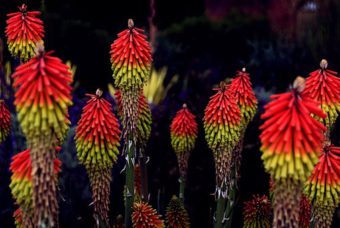
This is not the case as some perennials are evergreen or semi-evergreen, in that they retain their leaves during the winter months. They may retain all their leaves if they are true evergreens, or lose some leaves if they are semi-evergreen.
In some species of perennial both possibilities exist, so that in some varieties they retain most of the leaves, whilst in other some leaf losses are to be expected.
These are useful plants where patches of greenery can exist amongst containers that are normally empty. This will most certainly brighten up vacant container displays where nothing is visible until spring of the following year.
Use this article as a guide to inform of which evergreen or semi-evergreen can be planted amongst container displays, to give some greenery to look at:
ACAENA (New Zealand Burr)

This is a 5cm tall, spreading perennial that has multiple uses, where it can provide a blanket over bulbs and a cover between higher growing shrubs.
The leaves are bronze-green, where small spikes of pink flowers with yellow centres appear in July-September. These are followed by burr-like attractive seed heads from August onwards that are bright red in colour.
Look out for ‘Blue Hazel’ which had blue-grey leaves and darker red burrs. Grow this perennial in a well-drained multipurpose compost in full sun or light shade.
AETHIONEMA

This is a shrubby evergreen or semi-evergreen perennial that grows up to 30cm in height. It is a ground cover plant with fleshy grey leaves, which between May to August they are covered with pale pink or red flower heads.
A. grandiflorum is a giant, whilst A. oppositifolium is short, only growing up to 5cm in height.
It is best to raise them from seeds, where it can be planted in well-drained, multipurpose compost in full sun.
AJUGA (Bugle)
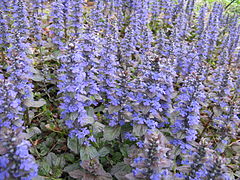
This perennial is grown for its decorative foliage but saying this, some varieties have decorative floral displays. Ajuga grows up to 15cm in height, where in late spring or early summer small, blue, white, or pink flowers appear on short stalks, above colourful leaves. Ajuga ‘Alba’ and ‘Pink Elf’ are grown for their flowers, which are white and pink respectively.
The variety grown for its leaves are ‘Burgundy Glow’ (creamed edged red), ‘Braunherz’ (purple), ‘Atropurpurea’ (purple), and ‘Multicolor’ (Green, red, bronze and cream).
It is not a fussy plant and will grow in any compost in full sun or partial shade.
ALYSSUM (Aurinia Saxatilis)

Most alyssums are hardy annuals used for bedding schemes, but a group exists that is not only perennial but also quite attractive. This 30cm tall perennial has large heads of tiny yellow flowers, which cover the grey-green evergreen leaves.
Grow this perennial in a well-drained, multipurpose compost in full sun.
ANTENNARIA (Cat’s Ear)

An unspectacular and unpopular perennial that has one useful feature, as it can be trodden on with no harm.
This 15cm tall, spreading perennial forms a dense mat of narrow, silvery leaves, which are ideal to cover bare ground amongst bulbs. In May to June, small, white, pink, or red flowers appear. Not fussy about what compost it is grown in, but the preferred choice is to grow it in a well, drained multipurpose compost in full sun.
ARABIS (Rock Cress)

This perennial that grows up to 25cm in height produces white, double blooms in early spring over grey-green leaves. It is not the only colour as pink and red flower varieties also exist. It can be seen as invasive and would require to be cut back hard after flowering has finished. Arabis will do well when grown in a well-drained, multipurpose compost in full sun.
ARMERIA (Thrift, Sea Pink)

This perennial has grass-like green leaves that are densely packed close together. In May to July, pink, red, or white, globular, papery blooms appear. Grow this quick-spreading perennial in well-drained, multipurpose compost in full sun.
ARENARIA (Sandwort)

This will make an excellent background display in a container. This 10cm tall perennial has grassy-like green leaves, where in late spring to early summer, small white flowers appear on short stalks. This type of Arenaria (A. maritima) likes to be grown in full sun, whilst mossy-leaved A. balearica prefers to be grown in deep shade.
Grow it in a moisture-retentive, well-drained multipurpose compost in full sun or shade, depending on which variety is grown.
AUBRIETA (Rock Cress)

This familiar perennial that cascades over walls and stones in many gardens across the UK. The grey-green leaves are covered with pale purple, pink, red, or blue flowers that appear in March to Early June.
The leaves are covered with masses of blooms. The small leaves can also be gold-edged ‘Aureovariegata’or ‘Astrolat’, a variegated variety.
Grow this perennial in well-drained, non-acidic, multipurpose compost in full sun.
BERGENIA (Elephant’s Ears)

This is a spectacular perennial that grows up to 45cm in height. It has a lot of positive features; it thrives under shrubs and trees, keeps weeds down and provides colours all year round. Most Bergenia start as green leaves but turn red in autumn. Over the large, oval leaves, red, pink, purple or white flowers appear in spring. This is not a fussy plant and will do well in a well-drained, multipurpose compost in full sun or partial shade.
BRUNNERA (Perennial Forget Me Not)

This 60cm tall perennial tends to flower twice per year, It is an easy plant to look after, where it does well under trees or providing flowers early in the growing season, where nothing is in flower.
In early April to June and in autumn, pale blue flowers appear over large, heart-shaped leaves. The leaves themselves are very attractive and comes in different shades and markings.
You can have white-edged leaves or cream-edges leaves or even silver-spotted leaves. It does not like its roots to be dry and so you will need to water well in dry spells.
Grow it in a well-drained, multipurpose compost in light shade.
CERASTIUM (Snow in Summer)

This 10cm tall perennial has silvery-grey, oblong leaves in which white flowers cover the whole plant in May to July. It is a quick spreader and so it is best to grow as a sole specimen in a container where its aggressive nature can be controlled.
One of the big pluses for this plant is that it does well when the compost is dry. Grow it in a well-drained, multipurpose compost in full sun.
CORTADERIA (Pampas Grass)

Evergreen grasses are ideal for winter displays as they do stand out. This perennial enhances the decorative features of container displays but this will stand out on its own. With 45cm tall, silvery plumes, the plant itself can grow up to 3m in height.
For best displays grow female species as they produce the best plumes. To be at their showiest the summers have to be hot and sunny, which does not happen very often.
Plants as a sole specimen in a well-drained multipurpose compost in full sun or light shade. The spent flower stems need to be removed in late autumn.
DIERAMA (Wand Flower)

This giant bulb growing up to 15cm in height produces an eye-catching display whenever it is seen. The plant has narrow, green leaves from which tall spikes of deep pink, red-purple, white or violet bell-shaped flowers appear in summer.
The stems are often weighed down by the blooms that are produced. Plant corms in late autumn or spring in a well-drained, multipurpose compost in full sun. This is not usual as often you buy it as a pot grown specimen.
DRYAS (Mountain Avens)

This is an easy to grow perennial that looks good in any container displays. The woody stems have leathery evergreen, oak-like shiny leaves that are silvery below. In late spring on short stalks, white, yellow centred flowers or totally yellow flowers appear.
Grow this stunning plant in a well-drained multipurpose compost that is non-acidic in full sun.
ERYNGIUM PLANUM (Sea Holly)

This evergreen variety of sea holly has a rosette of thistle-like silvery-green leaves, where branching stems of a blue hue appear. The stem is topped with a blue, cone-shaped flowers with spiked- fluffs around them. This 25cm tall perennial flowers in July to September, where it can be in bloom for around 3 months.
The seed heads are attractive and can be left on the plant over winter to add interest.
Grow this plant in a well-drained multipurpose compost in full sun.
ERYSIMUM (Perennial Wallflower)
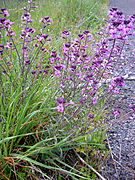
Ordinary wallflowers are in flowers for a month or two, whilst its cousin is in flower for at least 9 months of the year. There are a number of species available from 15cm dwarfs to 75cm tall plants. The one to look for is ‘Bowles Mauve’ which produces mauve flowers from March to November, where it looks quite shrubby. Other varieties flower between April and June, where flowers come in colours of yellow, red-orange, and deep red.
The only major drawback is that the plant tends to not be long-lived. Grow it in a well-drained, multipurpose compost in full sun.
FRANKENIA
This is a rare perennial that is not often grown or seen in most people’s garden. A description has been disclosed in my article of usual varieties of perennials to grow in containers, and there will not be repeated here.
HELIANTHEMUM (Rock Rose)

This perennial produces long-lasting flowers that last throughout the summer months. This 20cm tall plant has long, oval-shaped, narrow green leaves. On top of these white, yellow, pink, or orange flowers are produced in large quantities. Each flower only lasts a day or two but are readily replaced throughout the summer months.
Cut back hard after the first flush, as this will induce it to produce a second flush and more importantly to keep it in check. Plant it in a sandy, well-drained, multipurpose compost in full sun.
HELICHRYSUM

This is a plant that comes as annuals and perennials. The perennial is, of course, the evergreen variety. Unlike the annuals, the perennials are shorter, only growing to 7.5cm in height and they are grown more for the leaves rather than their flowers. Saying that there are two varieties that are noted for their flowers; H. bellidiodes has white flowers with yellow centres on short stems that appear in June-August, H. milfordiae produces red buds, which open to form large, white flowers.
Grow this perennial in a well-drained, multipurpose compost in full sun.
HELLEBORUS (Hellebore)
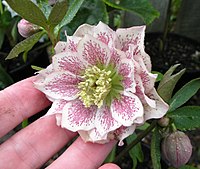
Hellebores come in deciduous and evergreen varieties with the popular varieties being evergreen This 45cm tall perennial has deeply-loped, green leaves that flowers from January to April, so cover most of the winter months. The plants are easy to look after water in dry weather and protect from slugs and snails.
The Christmas rose H. niger produces white flowers with yellow centred stamens from January to March. The Lenten rose (H. Orientalis) come in a range of colours from white, cream, yellow, green, pink, red, purple or even black.
The flowers appear from February to April. All flowers have some form of markings and therefore make more striking features than Christmas rose. Grow this perennial in well-drained enriched multipurpose compost in partial shade,
HEUCHERA (Coral Flower)

These perennial are noted for their colourful leaves rather than their flowers. Although to some they both look as good as each other. They have lobed, hairy, and veined leaves that are either silver-marbled, purple or grey-marbled, On top of these leaves, small, bell-shaped flowers appear on upright stems. The flowers are either white or pink.
Plant this beauty in a well-drained multipurpose compost in full sun or light shade.
IBERIS (Candytuft)
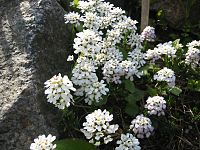
Another plant that comes in perennial or annual form. The perennial variety has long, narrow green leaves in which white flowers with four-petal are produced, all over the plant in April to June.
For containers I suggest you grow ‘Little Gem’ or ‘Pygmaea’, which only grows up to 10cm in height, otherwise, it can be quite invasive.
Grow this perennial in a well-drained, multipurpose compost in full sun.
KNIPHOFIA (Red Hot Poker)

This perennial forms clumps of grass-like, green leaves from which spikes of long, tubular flowers appear. The flowers can be the traditional red at top and yellow at the bottom, or they can be monochromic in colour. The colours can be white, yellow, orange, red, and green, so cover a wide range. Grow this well-known perennial in a well-drained, multipurpose compost in full sun.
CONCLUSIONS
In this first part of the series, we have discussed evergreen perennial plants for the container garden. Perennial from A-K have been discussed, leaving L-W to be enclosed in the second part of the series.
Evergreens are important in container garden as they can provide colour, especially in the dreary, winter months where perennials are normally nowhere to be seen. Shrubs are more often seen than perennials and this is why this article was written.
To tell gardeners that you can have greenery in autumn and winter rather than staring on to empty pots, waiting for replanting or regrowing the following growing season. The added benefit is that evergreen perennials tend to require less maintenance than deciduous ones, and therefore desirable for less keen gardeners.
In the second apart we will continue our journey with more beautiful evergreen or semi-evergreen perennials. Looking forward to seeing you then.
If you have any questions that need asking or comments you like to make, please do so in the comment box below.

I believe this is the second post I am reading from you, I can’t regret subscribing to your newsfeed, the other article I shared with my mum and I am sure he is making something out of it, u just like the way you present your details, I personally don’t know more about this container plants but am sure your articles are really helpful to many and specifically to my mum, kindly keep updating us with more of similar post.
Thank you
Hi Joy
Gardening is good for the mind and the soul. It is good that you are letting your mum aware of the work that I am punishing and I have many more ideas in the pipework. Gardening is all about ideas, how to present them and how to get the most out of them.
Thanks for stopping by and commenting.
Antonio
Thanks for sharing this amazing and informative article about evergreen perennial plants for container gardens, it’s very disheartening that some plants dies immediately it’s winter and they leave no green scenery that makes it really pleasant in our gardens. This list will serve as proper guide for people willing to go into container gardening and also some of us that are already in the system. Thanks.
Hi KingAndrea
Thank you for those warm and kind words. Evergreen shrubs are more common in the garden than evergreen perennials and so I wanted to readdress the balance, hence why these articles were written. I am glad you enjoy them
Antonio
Wow. You did something special with these plants.
My favorite plant is Ajuga. It gives a very nice look to my garden. I find it extraordinary how such a plant can grow 15 cm and withstand so well against the strong wind in the region where I am. I keep it partially in the shade and at certain times of the day when the sun is on the sky they look wonderful.
Thank’s a lot. Best wishes.
Hi Nimrodngy
Thank you for those kind words and Ajuga is indeed a beautiful plant to grow, as the colours are very spectacular.
Evergreens fill a void of empty space that is so common in winter, so why don’t you plant a plant or two.
Kind regards
Antonio
Hello admin thanks very much forr this wonderful article about evergreen perennial plants for the container garden. It has really been interesting because I have been with empty containers planning which plants to grow but by this article, I have got to know which plants to grow and am soon looking for them. Thanks very much for this article admin and am eager waiting for the L to W review.
Hi Mugalu
Gardening is so much about colour and texture, where evergreens can do both at the time of year where everything is lacking in life. These articles are written for this purpose. The second part can be found here Evergreen Perennial Plants for the Container Garden- Part II L-W (Have Even More Greenery in Winter).
Thanks
Antonio
It is a very common thing that most plant experiences when winter approaches that they die, I think it’s a very good idea to provide us with details about some perennial that can survive the through all seasons and be evergreen. I’ll definitely bookmark this page because I need to add some of these plants to my garden. I’ll share to some of my friends who keeps container gardens.
Hi Wildecoll
It is great to have some greenery when everything is do brown and dying back. These articles will fill the void and least you will have some colour in this dreary time of year.
Kind regards
Antonio
I can’t really wait to see the second series of this article, its very thoughtful of you to share this article, i always have this same problem with season change as it most times affect plants in my container garden. I’ll look into this list and I’ll select some perennial plants to include in my garden. I find this article very lovely and useful.
Hi Roslinecar
Thank you for stopping by and commenting. I try to come up with ideas that are helpful to gardeners. The second part can be found here Evergreen Perennial Plants for the Container Garden- Part II L-W (Have Even More Greenery in Winter).
Kind regards
Antonio